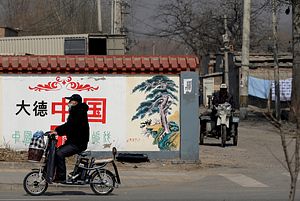Rural Chinese villages are searching for the equivalent of their “World’s Biggest Ball of Twine” in the hopes of attracting tourists and reshaping the countryside.
There’s already “Sock Town,” the world’s largest producer of socks, a “Sweet Town,” named after its recently opened chocolate factory, and eventually there will be a “Happy Town,” which hopes to be known for its sex toy market and other adult offerings.
Thanks to a new initiative, China will soon be home to a thousand of these government-approved “charming towns.”
In keeping with President Xi Jinping’s goal to transform China into “a beautiful country” by 2050, the central government plans to turn ailing villages into themed “charming villages” in the hopes that they will become prime tourist attractions, create a thriving economy, and help narrow the urban-rural divide that has left much of the rural population in poverty.
To date, the Ministry of Housing and Urban-Rural Development has approved over 400 charming towns, but provincial governments have also seized on the plan and are implementing it locally. In Xinjiang, officials have approved 100 of these towns.
Anchored by a particular manufacturer or industrial base, these villages are hoping that with some clever branding, the right theme, and preferential policies they can attract tourists as well as businesses from a targeted industry.
Once a producer of animal feed, Sweet Town, situated just south of Shanghai in Zhejiang province, turned to a sugary theme for economic development after opening a chocolate factory. Now the town boasts sprawling fields of flowers, a hot spring, and scenic rail car rides. In 2016, 1.75 million tourists visited, a 45 percent increase over the previous year.
Meanwhile, in Zhejiang’s capital sits Dream Town, which hopes to be the next Silicon Valley. The town is luring startups with the promise of free office space as well as basic infrastructure facilities.
Sweet Town and Dream Town are among first wave of charming towns that helped inspire the nation-wide policy.
In 2015, the provincial head of Zhejiang announced plans to invest 500 billion yuan ($75 billion) to create 100 charming towns with distinct themes over three years. Each town would receive at least 5 billion yuan ($750 million) to turn a three square kilometer area into an industrial park or other specialized attraction.
After visiting Zhejiang, Xi, who served as Party secretary of the province from 2002-2007, revealed plans to take the policy nationwide.
“I’m not surprised that the whole idea came from Zhejiang, because it’s the best at industrial clustering,” Professor Hu Zhiyong, who researches industrial transformation and regional development at the Education University of Hong Kong, told the South China Morning Post.
“Every town has its own unique industry, a brand company. Many of these towns simply changed their ways of marketing as a fresh ‘charming town.’ It’s basically new wine in an old bottle.”
The latest initiative comes as officials in Beijing seek to bridge the widening chasm between urban and rural residents.
While the nation’s booming economy has generated significant wealth and lifted millions out of poverty, it has also led to growing inequality. In 2014, urban residents had three times as much disposable income per capita as rural residents.
This disparity is also reflected in the allocation of government resources. Last year, the government spent 1.74 trillion yuan ($262 billion) on constructing public facilities in cities, but only 402.6 billion yuan ($60 billion) in rural areas.
Decades of uneven development have resulted in millions of rural residents leaving the countryside and heading to cities in search of opportunities. China is now home to an estimated 250 million domestic migrants, or nearly 20 percent of the nation’s population.
As the government caps the population of its major cities, forcefully evicting migrants from their homes, officials see charming towns as a way to lure residents back to the countryside, rebalance development, and bring much needed public services to rural areas.
But some experts are skeptical of this plan.
“The biggest problem with these charming towns is they lack economies of scale,” said Lu Ming, an economics professor at Shanghai Jiao Tong University.
Lu predicted these towns will fail in the long-term, as they are located far from major cities where high-end manufacturing is located as well as the demand for goods and services.
Officials are also wary of speculation that could lead to more ghost towns. In the last decade, overzealous local officials and developers went on a debt-fueled building spree that created empty cities with enough capacity to house two billion additional residents.
Speaking at a conference earlier this year, the head of development planning at the National Development and Reform Commission, Xu Lin, said that many charming towns have already turned into ghost towns with no residents or businesses.
Still local officials appear eager to cash in on the policy, putting their creativity to the test. But so far imaginations seem limited. There are over 30 “Hedge Fund Towns” – nearly half in Zhejiang – which take inspiration from Greenwich, Connecticut.
But the Western influence stops there. The government said that it will block the use of “big, Western and bizarre constructions” and bar the use of Western names. Unfortunately for China, it looks like there won’t be any giant balls of twine appearing any time soon.
Eugene K. Chow writes on foreign policy and military affairs. His work has been published in The Week, Huffington Post, and National Interest.

































